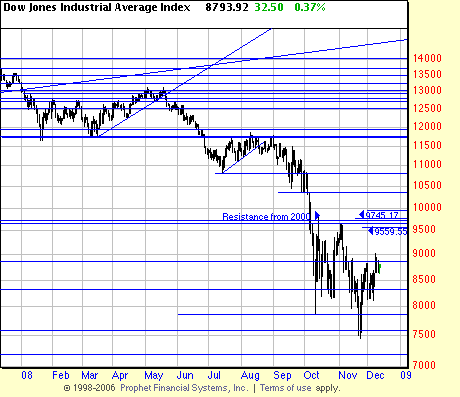We were reading our last letter and wondering if it made any sense to our readers. We’re not sure it made any sense to us. So in order to impose some sense on the situation we calculated the stops on the Dow. These make sense, insofar as sense can be made of these markets. Remember, it was Keynes who said the markets can remain irrational longer than you can remain solvent. Funny thing, Keynes is back in fashion, even with neocons.
 The near stop is a bp+3%, the higher, +5%. We are inclined to favor the 5% stops because of the hair raising volatility of these markets. Approx. 17% rally since November 21!.
The near stop is a bp+3%, the higher, +5%. We are inclined to favor the 5% stops because of the hair raising volatility of these markets. Approx. 17% rally since November 21!.
Readers familiar with the 9th edition and our other writings know how strongly we advise the use of scaling in and scaling out methods. As we said previously, if hedging we would scale into hedges, and be ready to scale right back out. While taking a 17% move against your position if a short trend trader is eye popping and irritating the truth is that truly great long term profits are made by the patience to absorb such moves. And the Basing Point System indicates that is the proper posture. Remember the problem with Dow Theory, and trend trading, is that it gives up the first third and the last third and sometimes (according to the wags and the critics) there isn’t a middle third.
The purpose of Basing Point stops is to allow the market to wreak its carnage on investors and traders whose stops are too tight. And to allow Magee type investors to observe waves against them with equanimity knowing that they will either be stopped out with handsome profits, or on the wave reversal they will be able to lower their stops and lock in yet more profits.
In this process the bottom fishers, the quick guns and the impatient jump in and out damaging their accounts as much as their psyches.


Maybe I need to reread book again — bp+3% or 5%….but how/where are you defining a basing point?
Nevermind….I re-read chapter 28 and I’m good…thanks for the analysis as always.